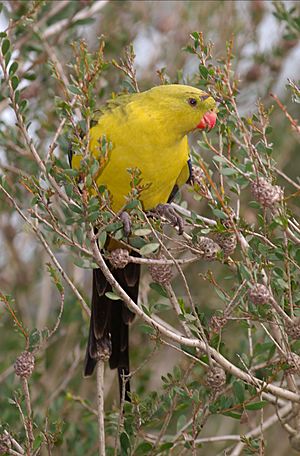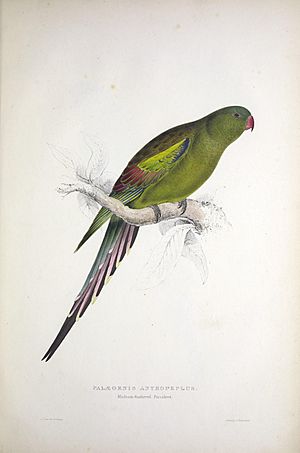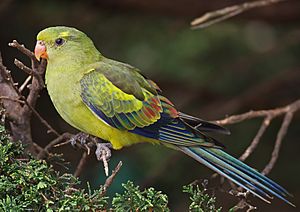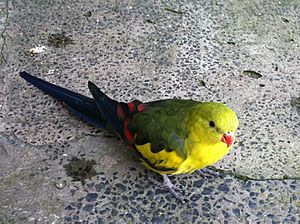Regent parrot facts for kids
Quick facts for kids Regent parrot |
|
|---|---|
 |
|
| Conservation status | |
| Scientific classification | |
| Genus: |
Polytelis
|
| Species: |
anthopeplus
|
| Subspecies | |
|
P. a. anthopeplus |
|
The regent parrot, also called the rock pebbler, is a beautiful bird that lives in southern Australia. This parrot is mostly yellow with a green tail. You can find it mainly in eucalyptus forests and other wooded areas in southwestern Australia. It also lives in a smaller part of southeastern Australia. These parrots mostly eat seeds.
Contents
About the Regent Parrot
The regent parrot is part of a bird family called Psittaculidae, which includes many types of parrots. It is closely related to the superb parrot and the princess parrot. The name anthopeplus comes from ancient Greek words meaning "flower" and "robe," which might describe its colorful feathers.
There are two main groups of regent parrots, which look very similar but live in different areas of Southern Australia. These groups are known as subspecies:
- Polytelis anthopeplus anthopeplus: This group lives in Southwest Australia.
- Polytelis anthopeplus monarchoides: This group lives in Southeast Australia.
The regent parrot was first drawn by an English artist named Edward Lear in 1831. He included pictures of both male and female parrots in his book, Illustrations of the family of Psittacidae, or parrots.
People have given the regent parrot many other names over time. Some of these include the rock pebbler, Murray smoker, Marlock parakeet, and yellow king-parrot. In the Nyungar language of Southwest Australia, some names for this bird are Waukanga and Wookonga.
What Does the Regent Parrot Look Like?
The regent parrot is a long, slender bird, usually yellowish-green. It measures about 37 to 42 centimeters (14.5 to 16.5 inches) long and weighs around 113 grams (four ounces).
The male parrots are usually brighter yellow, especially on their heads. Their backs have many shades of green, and their beaks are often red. Female parrots are generally more green than yellow. Both males and females have dark blue-green tail feathers on top, which are black underneath.
Young birds look more like the females and have duller colors than the adult males.
Regent Parrot Behaviour
Regent parrots are social birds. They often fly in pairs or in small groups of up to twenty birds. In Southwest Australia, where they are very common, you might even see large groups of up to one hundred birds flying together. When they fly, their movements are fast and graceful, with their wings swept back.
How They Find Food
Regent parrots spend most of their time feeding on the ground, looking for grass seeds. They also eat seeds and blossoms from trees, especially acacia and eucalyptus trees. Their diet also includes fruits, leaf buds, and nuts from native plants. The parrots in Western Australia have learned to eat fruits and grains like wheat, which were brought to the area by European settlers.
Reproduction and Life Cycle
Regent parrots build their nests deep inside hollows of large trees, usually eucalyptus. The hollow can be very deep, sometimes reaching almost to the ground. The female parrot lays about four eggs in this nest.
The female sits on the eggs for about 21 days. During this time, she rarely leaves the nest, and the male brings her food. Once the chicks hatch, both parents take care of them. They feed their young many times, giving them much more food than they usually eat themselves. The young parrots start to fly when they are about 5 weeks old. They become adults and can have their own babies when they are about 2 years old.
Conservation Status
The regent parrot's conservation status depends on where it lives. The western subspecies (P. anthopeplus anthopeplus) is considered "least concern," meaning it is not currently at high risk. However, the eastern subspecies (P. anthopeplus monarchoides) is listed as vulnerable under Australian law. This means it faces a higher risk of becoming endangered. A plan was created in 2011 to help protect this vulnerable eastern group.
Sometimes, in Western Australia, these birds are seen as a pest by farmers because they can eat crops.
Regent Parrots in Captivity
Regent parrots are sometimes kept as aviary birds, often called rock pebblers or regents parrots. However, they are not suitable as pets for everyone. Only people with a lot of experience should care for them, and they need large, free-flying aviaries.
In captivity, regent parrots eat chopped food mixes made for large parrots. They also enjoy special egg food, fruits, sprouting seeds, and a few insects. Unlike many birds, parrots usually do not need grit in their diet unless a vet says they do for digestion. Giving them fresh branches from willow or fruit trees can make their homes more interesting. Regent parrots are naturally strong birds, so they don't need too much special protection from drafts. However, they should be kept safe from very cold weather, as they are not used to it in their natural home.
See also
 In Spanish: Perico regente para niños
In Spanish: Perico regente para niños





